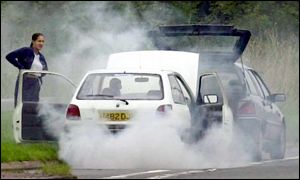It’s important to pay attention to your car and look for signs that the engine may be overheating. This can be your car’s quick route to the junkyard-if you don’t act fast.
An overheated engine can occur at any time; hot days and stop-and-go traffic are an especially tough combo. Be aware of the temperature gauge in the dashboard creeping up into the red zone or a warning light screaming “TEMP.” Or worse yet, steam billowing from under the hood. Lots of things can cause an engine to overheat, such as a loss of coolant due to a leaking hose or radiator, a worn or broken fan belt, a bad water pump or thermostat, or an electrical problem. It can even overheat on a cold day if the coolant is too diluted with water to keep it from freezing.
If your car has a temperature gauge, get to know where the needle is normally. If it’s higher, that could be your first sign of trouble. Get hoses and belts checked periodically. Replacing these or a thermostat often costs less than $100 to $200; larger repairs will be pricier. But that’s still far less expensive than repairing or replacing an engine.
Here are some steps to take if you notice your car starting to overheat.
- Turn your heater on full blast. That helps drain some heat from the engine while you find a place to stop. It is a helpful little trick to use even when the temperature gauge is running high but not in the red zone.
- Get off the road and stop. As soon as you can, drive to a safe location and turn off the engine.
- Lift the hood. That will help the engine cool down faster. But don’t do it if steam is coming out. And don’t remove a hot radiator cap. Hot, pressurized coolant and steam could erupt from the radiator, burning your hands. And never add cold water to an overheated engine; the abrupt temperature change can severely damage the engine.
- Let the engine cool down. Normally it takes at least a half hour to an hour for a hot engine to cool down. If you want to call for roadside assistance, now’s the time. You might need a tow truck.
- Check the coolant tank. It’s a translucent plastic tank located under the hood, near the radiator. If it’s empty, suspect a leak, which you’ll be able to detect if there’s liquid dripping from under the engine. Engines are designed to use coolant that’s a 50/50 mixture of antifreeze and water. If you have coolant in the right mixture, you can add it to the coolant tank or the radiator-but only after it‘s cool to the touch. If you don’t have coolant, you can simply pour water into the coolant tank so you can limp along to a repair shop. On the other hand, if there’s plenty of coolant in the tank, the overheating could be caused by an electrical or mechanical problem. Adding more coolant won’t help.








![[PHOTOS] Top 20 Used Cars to Avoid Buying in Kenya](../../../blog/wp-content/uploads/2013/11/top-used-unreliable-cars-to-avoid2-100x70.jpg)





